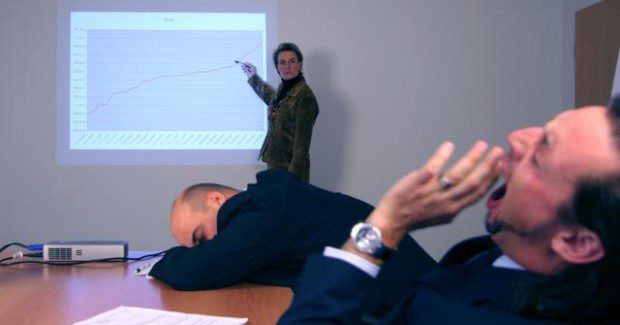A Listener’s View: We Are Our Presentations
This article isn’t about how to make a presentation because, in spite of all sorts of presentation training, few are effective. Instead, this focuses on how to understand what you’re doing when you are presenting, big or small –– to close a sale, to motivate your sales team, to engage your employees on the shop floor, to direct your management team, or meet with your bankers about a new loan for your business –– this is about how to keep your listeners front and center, where most presentations fall horribly short.
Posted: September 20, 2013
The goal of every presentation is to successfully influence how listeners will think or act. If that’s so, few presentations make the cut. Although many treat presentations rather casually, every one counts and each one is equally important. And here’s why: we are our presentations. We’re the one on stage, and we’re judged by our listeners not only by what we say –– but by the effectiveness of the performance.
Every presentation tells a story –– our story. It’s that serious because presentation skills influence the destiny of a business career –– and the advantage goes to the top presenters. Whether speaking one-on-one or to hundreds, it’s always a presentation. Formal or informal, it’s always a presentation. Whether it’s long or short, it’s still a presentation. Whether it’s a sales speech, management briefing, staff meeting or discussing a concept, plan, or presenting a proposal, it’s all the same –– it’s a presentation and the presenter is on the line. Here’s the way to make every presentation a success:
1. Start with asking, “What do I want someone to say, do or think after hearing my presentation?” If you don’t have a clear picture of how you want listeners to respond, they will be confused and dissatisfied. A presentation gets a focus and comes under your control when you know exactly how you want it to be perceived. Write down your answer and make it specific so it becomes your built-in GPS as you develop your presentation. If you don’t, expect a low grade from your audience.
2. Think about some presentations you’ve heard lately at work or anywhere else. What didn’t you like and what was good? Again, write down your answers and then get it right when preparing a presentation:
• What didn’t you like?
__ Went too fast or too slow
__ Boring, no excitement
__ Too long
__ Hard to follow
__ Too much information
__ Not enough information
__ Didn’t learn anything
__ Heard it before
__ Not prepared
__ Sounded like a lecture
__ Didn’t involve listeners
__ Confusing, couldn’t follow
__ Not organized
__ Didn’t understand the listeners
__ Talked down to us
__ Poor use of media aids
• What did you like?
__ Good stories
__ Involved listeners
__ Well organized
__ Easy to follow
__ Energetic
__ Right length
__ Good pace
__ Learned something new
__ Understood the listeners
__ Helpful information
__ Interesting
__ Well prepared
__ Wanted to hear more
__ Good use of media aids
3. A presentation is always a “joint venture” between presenter and listeners. It belongs as much to them as it does to you. This is why pretending they’re looking over your shoulder as you’re preparing it is a good way to think about it, but it also makes it hard work. How so? Because a presentation is always a compromise between what you want to say and what the audience wants to hear. Having a thorough understanding of the audience (who they are, what they’re thinking, what they’re looking for, the problems they face and so forth) is essential in reaching the goal of successfully influencing how they will think or act so they will want to do business with us.
4. Connect with your listeners by using stories. The good news is that listeners want to believe in you as someone who cares about what they care about. Unfortunately, this occurs infrequently. The way to do it is with the right stories, those that keep the focus on your listeners. Nix those about yourself, your company, your job, your dog, your significant other, or your vacation –– unless they’re a good fit for your audience. If you have kids, you may have great stories, but leave them at home. If you don’t you’ll lose your listeners. Always keep in mind that your presentation is about them, not you. Here’s an example of a story that works:
The page-one story in The Boston Globe told of an unemployed 58-year-old man who spent two years job-hunting. Trying for a middle management job in the computer industry, he had sent out hundreds of resumes without a nibble. Now, he thought he might never work again. Yet, buried in the story was a telling comment. Years before he was known as “Mr. Fixit.” It was something he loved doing. So, fixated on getting a job, he was blind to the one staring him in the face. There are times when we’re so stuck on going in one direction, we miss the opportunities that are in front of us . . . Always keep your “antennae” up. The best stories come from everyday experiences, news articles, biographies and even ads.
By using stories to connect with your listeners, something important happens to a presentation. Slides, that common tool that’s too often used as a crutch, become far less important. If you use them as a roadmap to let the participants know where you’re going, use words sparingly –– one or two on a screen with a graphic or a short video, perhaps. The objective is to keep the focus on the audience, not the visual aids.
5. Write them out word-for-word. “But that’s a lot of work and this is just an informal presentation,” someone says. Of course, it’s work, but the deadly mistake both new and experienced presenters make is cutting corners on preparation, starting with thinking that writing out presentations isn’t needed. The writing is a given only if you want to make winning presentations. If you don’t write it out, count on forgetting something, missing or messing up a major point or say something you’ll regret.
6. Turn on your presentation GPS. From the get-go, you have no more than 30 seconds to grab attention and make clear what you want to accomplish. One presenter looked at the audience of 75 or so life insurance agents and said, “Only three of you are going to get rich. How do I know? Only three of you will do what it takes to get there.” What follows are the three steps a life insurance agent must take to reach success –– and this is where stories, supported by facts, can help engage listeners.
Then, wrap it up, summarizing what you want the listeners to remember about your presentation and, close with a challenge. Here’s how the presenter did it with the life insurance agent audience. “About 40 of you may be thinking that it sounds interesting, but I’m doing pretty good now,” he said. “Another 25 has found something they would like to try, while seven are thinking you want to get on board, but will drop off tomorrow by early afternoon. That leaves only three, the ones who will strike it rich.” By the way, never end with a question or a quotation. It’s the easy way out, but it doesn’t work. Always end with your own words.
7. Get some coaching. This seems to be the universal solution today. Yet, it can be a big help for presenters. No, don’t fret because you can’t hire Scott Pelley or Diane Sawyer (although just watching them in action is an education for presenters). Your best bet may be in the next cubical, a friend or a significant other. It’s a person who recognizes how much you want to do well. Then set the stage with your new coach. “Be honest. Make some notes and let me know what you like and what you don’t –– and why. Then we can talk about it.”
Can’t find a live coach? Get a digital one. Prop up your smartphone, tablet or laptop and video your presentation in three- to four-minute segments (yes, watching may be a bit overwhelming at first). Play them back and do it again, and again. You’ll be amazed at the improvement, and you’ll hear and see where you will want to make edits to the text. You may be ready for YouTube! Making great presentations is an immense challenge. They’re never spontaneous, never left to the last minute, and never read from PowerPoint screens. They’re always written, always edited and always rehearsed. Those who do it best are those who recognize that giving a presentation isn’t what they do; it’s who they are.
















